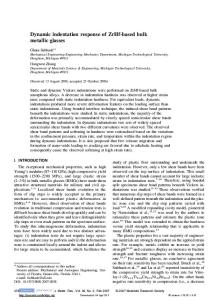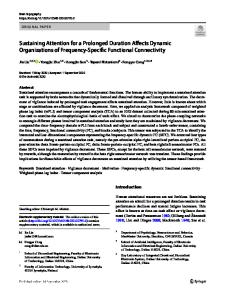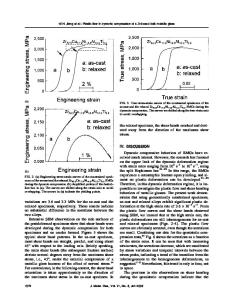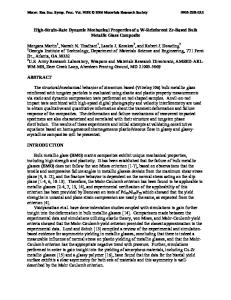Dynamic Specific Heat of a Metallic Glass-Former
- PDF / 83,718 Bytes
- 6 Pages / 612 x 792 pts (letter) Page_size
- 88 Downloads / 321 Views
Dynamic Specific Heat of a Metallic Glass-Former Gerhard Wilde Forschungszentrum Karlsruhe, INT, P.O.B. 3640, D-76021 Karlsruhe, Germany
ABSTRACT Modulated temperature calorimetry measurements on the bulk glass forming Pd40Ni40P20 alloy are reported in the frequency range between 1/30 s-1 and 1/1000 s-1. These measurements represent the first experimental assessment of the slow relaxation modes of a metallic liquid over a substantial frequency interval. The results reveal the typical behavior known for dissipative systems. The frequency-dependence of the dynamic specific heat is compared to results of dynamic rheology measurements that have been performed on the same material at similar modulation frequencies to compare the dynamic response of the respective modes.
INTRODUCTION Traditionally, the glass transition that occurs during continuous cooling an undercooled melt without interference of crystallization has been described by the step-like change in the second derivatives of the thermodynamic potentials, e.g. the specific heat, that mark the loss of ergodicity in the sample. This kinetic transition will be referred to as the static glass transition. With reference to the flow properties that undergo the kinetic transition from fluid-like to rigid behavior at the glass transition, commonly a viscosity of ηgt = 1⋅1012 Pa s has been assigned to the undercooled melt at the glass transition temperature, Tgt. Applying the Stokes-Einstein equation, an intrinsic relaxation time, τ, for structural rearrangements of about 100 s – 1000 s has thus been associated with the characteristic dynamics of the deeply undercooled liquid at Tgt. However, it has equally long been known that the occurrence of the glass transition depends on the time scale of the experiment, i.e. on the applied cooling rate. During slow cooling, the onset of the static glass transition is shifted towards lower temperatures and equilibrium viscosity values well in excess of 1⋅1012 Pa s are observed without the undercooled liquid falling out of metastable equilibrium. Thus, the general observation that the calorimetrically obtained glass transition temperatures coincide with the temperatures at which the equilibrium viscosity amounts to ηgt merely reflects the fact that the characteristic time scales for the experimental measurements are usually restricted to a narrow interval. Moreover, it has been shown rather recently that the Stokes-Einstein equation is not valid in the glass transition region since this kinetic transition is dominated by highly cooperative molecular motions instead of single-atom rearrangements [1] and since the tracer diffusivities of the constituents decouple in dependence of their respective sizes [2]. However, spectroscopic measurements of dynamic susceptibilities such as heat-capacity spectroscopy or dielectric loss spectroscopy [3] have been reported to give direct access to the relaxation time spectrum of the attenuated modes of the undercooled liquid. In this respect, the measurement of the dynamic specific heat, C*, as th
Data Loading...











